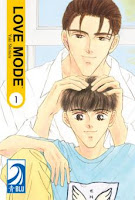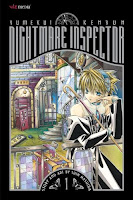My News and Reviews
Most everyone is probably aware by now of the terrible earthquake, tsunami, and resulting (and ongoing) disasters that struck Japan on March 11. Yokoso News, which normally focuses on Japanese culture and such, has been providing live English coverage of Japanese news sources for the last few days. They’ve been doing a great job and I’ve pretty much been listening to the broadcast whenever I get a chance.
My posts for this past week included two reviews. The first was for The Guin Saga, Book One: The Leopard Mask by Kaoru Kurimoto. I didn’t enjoy as much as I hoped I would, but I will still be reading the rest of The Guin Saga volumes available in English. The second review was for Tow Ubukata’s award-winning Mardock Scramble, which I mostly enjoyed. Just don’t talk to me about Blackjack. Animemiz’s Scribblings has made the announcement for this month’s Manga Moveable Feast which starts next week: Announcing March 2011’s Manga Movable Feast and a Call for Contribution. The feast will featuring Aria by Kozue Amano. My contribution will be an in-depth review of the first volume of the prequel, Aqua, Volume 1.
Since I read Offered this week, I thought I’d mention a few recent posts made about other manga created by Kazuo Koike and Ryoichi Ikegami: Kate Dacey at The Manga Critic takes a look at Wounded Man as part of her Manga Hall of Shame feature, and Jason Thompson’s House of 1000 Manga focused on Crying Freeman a few weeks ago.
Comics Should Be Good at Comic Books Resources is featuring LGBT comics this month. The entire archive of posts can be found here, but I specifically wanted to mention Brian Cronin’s brief review and preview of Shimura Takako’s Wandering Son. The first volume of this manga is to be released by Fantagraphics in June; I’ve really been looking forward to this series ever since it was announced.
And finally, a few more websites have been added to the Resources page: Anime Research, Manga Widget, Masters of Manga, and Same Hat!
Quick Takes
 Immortal Rain, Volumes 3-8 by Kaori Ozaki. I am in love with this series. The characters are great, the artwork is wonderful, the plot is both heartfelt and exciting. The more melancholy aspects of the story (of which there are plenty) are balanced nicely with moments of humor and quickly paced action. Rain is one of my favorite manga characters that I’ve come across recently. He’s adorable. Even after more than six hundred years of life, he has somehow managed to retain his humanity. I believe the eleventh and final volume is currently scheduled for release in Japan in May. Tokyopop has published the first eight volumes; I’m not sure what the plans are for the last few volumes, but I really hope they will be released, too.
Immortal Rain, Volumes 3-8 by Kaori Ozaki. I am in love with this series. The characters are great, the artwork is wonderful, the plot is both heartfelt and exciting. The more melancholy aspects of the story (of which there are plenty) are balanced nicely with moments of humor and quickly paced action. Rain is one of my favorite manga characters that I’ve come across recently. He’s adorable. Even after more than six hundred years of life, he has somehow managed to retain his humanity. I believe the eleventh and final volume is currently scheduled for release in Japan in May. Tokyopop has published the first eight volumes; I’m not sure what the plans are for the last few volumes, but I really hope they will be released, too.
 Love Mode, Volumes 1-2 by Yuki Shimizu. Love Mode is one of the longest boys’ love series currently available in English. The first two volumes rely a little too heavily on rape and the threat of rape to move the plot along, for me. Some people might also be bothered by the age differences between the couples. Fortunately, Takamiya is actually a really decent person. There is also a fair amount of humor, particularly in the first volume. In fact, there are moments that are absolutely hilarious and had me laughing out loud. I’m not particularly fond of Shimizu’s art style in this series; the first two volumes look a bit dated. Love Mode hasn’t really grabbed me yet, though I’ve been told it becomes quite addicting later on.
Love Mode, Volumes 1-2 by Yuki Shimizu. Love Mode is one of the longest boys’ love series currently available in English. The first two volumes rely a little too heavily on rape and the threat of rape to move the plot along, for me. Some people might also be bothered by the age differences between the couples. Fortunately, Takamiya is actually a really decent person. There is also a fair amount of humor, particularly in the first volume. In fact, there are moments that are absolutely hilarious and had me laughing out loud. I’m not particularly fond of Shimizu’s art style in this series; the first two volumes look a bit dated. Love Mode hasn’t really grabbed me yet, though I’ve been told it becomes quite addicting later on.
 Nightmare Inspector: Yumekui Kenbun, Volumes 1-2 by Shin Mashiba. Nightmare Inspector is surprisingly dark for as innocent looking as the artwork first appears. The character designs are appealing although it’s difficult to tell the relative ages of the different characters, they all look young. Hiruko is a baku, a creature that eats nightmares, the more bloody and painful the better. It’s mostly only been hinted up to this point, but there is something ominous about Hiruko’s existence and backstory. People come to him for help interpreting and dispelling their nightmares. The story is fairly episodic so far as each dream is explored, but it is genuinely creepy. I’m really looking forward to reading the rest of this series.
Nightmare Inspector: Yumekui Kenbun, Volumes 1-2 by Shin Mashiba. Nightmare Inspector is surprisingly dark for as innocent looking as the artwork first appears. The character designs are appealing although it’s difficult to tell the relative ages of the different characters, they all look young. Hiruko is a baku, a creature that eats nightmares, the more bloody and painful the better. It’s mostly only been hinted up to this point, but there is something ominous about Hiruko’s existence and backstory. People come to him for help interpreting and dispelling their nightmares. The story is fairly episodic so far as each dream is explored, but it is genuinely creepy. I’m really looking forward to reading the rest of this series.
 Offered, Volumes 1-2 written by Kazuo Koike and illustrated by Ryoichi Ikegami. I haven’t quite been able to decide whether Offered is so bad it’s good, or if it’s just simply bad. There’s a lot going on: Olympic athletes, drug cartels, Nazis, mummies, underground kingdoms, hypnotism, ancient sperm, nudist colonies, cults, animal sacrifices…did I mention ancient sperm? The manga is ridiculous and absurd and it’s played absolutely straight. The story is ludicrous, but the it presents itself completely seriously. I’m still trying to wrap my head around the whole thing. I am, however, a sucker for Ikegami’s artwork. His figure work is gorgeous and I can’t help but love it. I’m not sure I can recommend Offered, but it’s certainly an experience.
Offered, Volumes 1-2 written by Kazuo Koike and illustrated by Ryoichi Ikegami. I haven’t quite been able to decide whether Offered is so bad it’s good, or if it’s just simply bad. There’s a lot going on: Olympic athletes, drug cartels, Nazis, mummies, underground kingdoms, hypnotism, ancient sperm, nudist colonies, cults, animal sacrifices…did I mention ancient sperm? The manga is ridiculous and absurd and it’s played absolutely straight. The story is ludicrous, but the it presents itself completely seriously. I’m still trying to wrap my head around the whole thing. I am, however, a sucker for Ikegami’s artwork. His figure work is gorgeous and I can’t help but love it. I’m not sure I can recommend Offered, but it’s certainly an experience.
 The Great Yokai War directed by Takashi Miike. The Great Yokai War is the first film that Miike directed for children; he’s probably better known in the United States for his more controversial and extreme works. However, The Great Yokai War is a family-friendly romp featuring a delightful cornucopia of colorful yokai, a summer adventure, and quirky humor and visuals. I recently read Yokai Attack! and was thrilled to be able to pick out and identify many of the creatures in the movie. If a particular yokai happens to catch your eye, make sure to check out the gallery on the DVD which includes their names and usual locals. It’s really the yokai that make this movie for me, but the lead kid is freaking cute, too.
The Great Yokai War directed by Takashi Miike. The Great Yokai War is the first film that Miike directed for children; he’s probably better known in the United States for his more controversial and extreme works. However, The Great Yokai War is a family-friendly romp featuring a delightful cornucopia of colorful yokai, a summer adventure, and quirky humor and visuals. I recently read Yokai Attack! and was thrilled to be able to pick out and identify many of the creatures in the movie. If a particular yokai happens to catch your eye, make sure to check out the gallery on the DVD which includes their names and usual locals. It’s really the yokai that make this movie for me, but the lead kid is freaking cute, too.






